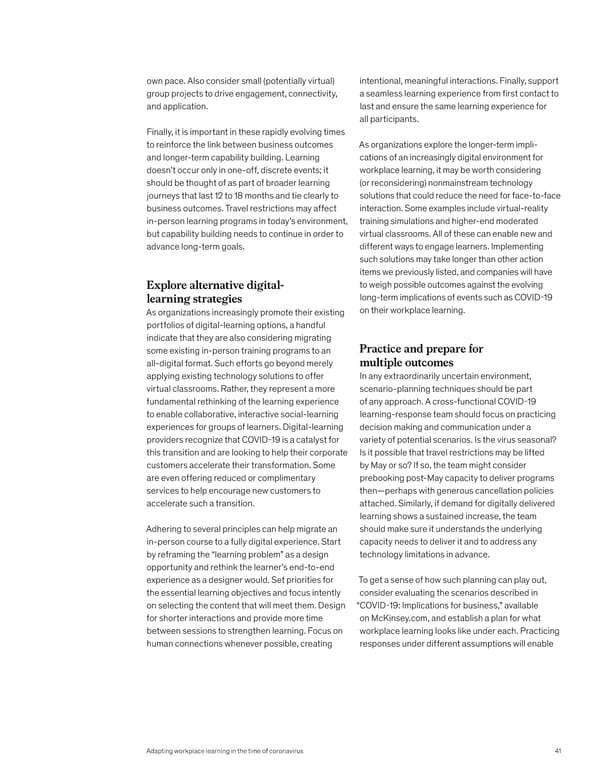own pace. Also consider small (potentially virtual) intentional, meaningful interactions. Finally, support group projects to drive engagement, connectivity, a seamless learning experience from first contact to and application. last and ensure the same learning experience for all participants. Finally, it is important in these rapidly evolving times to reinforce the link between business outcomes As organizations explore the longer-term impli- and longer-term capability building. Learning cations of an increasingly digital environment for doesn’t occur only in one-off, discrete events; it workplace learning, it may be worth considering should be thought of as part of broader learning (or reconsidering) nonmainstream technology journeys that last 12 to 18 months and tie clearly to solutions that could reduce the need for face-to-face business outcomes. Travel restrictions may affect interaction. Some examples include virtual-reality in-person learning programs in today’s environment, training simulations and higher-end moderated but capability building needs to continue in order to virtual classrooms. All of these can enable new and advance long-term goals. different ways to engage learners. Implementing such solutions may take longer than other action items we previously listed, and companies will have Explore alternative digital- to weigh possible outcomes against the evolving learning strategies long-term implications of events such as COVID-19 As organizations increasingly promote their existing on their workplace learning. portfolios of digital-learning options, a handful indicate that they are also considering migrating Practice and prepare for some existing in-person training programs to an all-digital format. Such efforts go beyond merely multiple outcomes applying existing technology solutions to offer In any extraordinarily uncertain environment, virtual classrooms. Rather, they represent a more scenario-planning techniques should be part fundamental rethinking of the learning experience of any approach. A cross-functional COVID-19 to enable collaborative, interactive social-learning learning-response team should focus on practicing experiences for groups of learners. Digital-learning decision making and communication under a providers recognize that COVID-19 is a catalyst for variety of potential scenarios. Is the virus seasonal? this transition and are looking to help their corporate Is it possible that travel restrictions may be lifted customers accelerate their transformation. Some by May or so? If so, the team might consider are even offering reduced or complimentary prebooking post-May capacity to deliver programs services to help encourage new customers to then—perhaps with generous cancellation policies accelerate such a transition. attached. Similarly, if demand for digitally delivered learning shows a sustained increase, the team Adhering to several principles can help migrate an should make sure it understands the underlying in-person course to a fully digital experience. Start capacity needs to deliver it and to address any by reframing the “learning problem” as a design technology limitations in advance. opportunity and rethink the learner’s end-to-end experience as a designer would. Set priorities for To get a sense of how such planning can play out, the essential learning objectives and focus intently consider evaluating the scenarios described in on selecting the content that will meet them. Design “COVID-19: Implications for business,” available for shorter interactions and provide more time on McKinsey.com, and establish a plan for what between sessions to strengthen learning. Focus on workplace learning looks like under each. Practicing human connections whenever possible, creating responses under different assumptions will enable Adapting workplace learning in the time of coronavirus 41
 What Now? Page 42 Page 44
What Now? Page 42 Page 44